
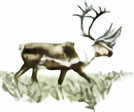

Elsewhere in this book I have mentioned the trade secrets of trappers and their reluctance to give information about methods by which furbearing animals could be taken. By now we had learned some things from experience. We had also heard a few trapping secrets dropped in drunken conversation. We knew that various scents could be used, anise oil, peppermint oil, catnip, and asafoetida which will lure some animals,. At Cree Lake it was the same. Trappers discussed everything under the sun, but were mighty close mouthed or misleading about their trapping methods.
Otters were found to favour certain creeks and rivers and areas where moving currents kept the water ice free. Mink had special hangouts about some islands in Cree Lake and on certain grassy creeks where crustaceans abound to serve as food. Beavers of course, left so much sign of cut trees that their presence could be detected most easily of all furbearers.
We reasoned that if there were no trappers, these animals would become so numerous that they would die of starvation and disease-equally appalling sights. There is a wealth of information to be observed in a bundle of fox pelts when examined by the initiated. An expert can tell, on examining a fox pelt, the month of the year in which it was taken. The skin side, if black or bluish signifies October or November. A full furred pelt with creamy white on the skin side means December, rubbed area on the fur, January and February. The skin side, tells if the animal was trapped, snared, or poisoned. The skin shows red discoloration on the leg caught in the trap.
There were foxes that were off-colour so that they could not be classified as red, cross, or silver, and were referred to by trappers as bastards. Normal in the length and texture of fur, however, they brought the same price as a red fox. On rare occasions we caught nature's jokes. These are runty foxes, with short, dark, woolly underfur and no guard hair at all and whose pelts are worthless. They have the appearance of being singed and are called Samson foxes after the bible story that tells how Samson caught foxes, set them afire, and drove them into the camps of his enemies. A story went with each pelt. Since no two skins are identical, each could be segregated and the story told by the trapper of how it was taken and when and where and under what conditions and peculiarities; an interesting subject at evening, after a long trapline patrol, in the home cabin recounting to one's partner the circumstances of each catch.
Muskrat, mink, weasel, and otter were also case-skinned, but dried with the fur side in and never reversed after being dried. Proper cleaning of these skins is essential and all traces of flesh and fat are removed, leaving the skin side an off-white or light amber colour. Beaver pelts are difficult to prepare for the fat is intergrown with the tissue especially in the area covering the shoulders, hips, and the base of the tail. Beaver are skinned open, that is, the skin is split from the chin to the base of the tail, the legs are pulled through and the skin cut at the wrists and heels, so that the finished product is oval shaped and skin side and fur side can both be examined. "And so, as it must be to all men, death comes to King George V of England," announced the news commentator as we switched on the radio one evening. Aside from its interest and news value, this fact was to have a favourable impact on fur prices for we were happy to learn that in the year of the coronation of King Edward VIII, fur prices suddenly turned sharply upward. Fur became so much in demand that Alex Ahenakew chartered Cecil MacNeal's plane for a trip to our cabin where he bought our catch up to early December for well over $900 a tidy sum in those days-about the price of a new car in Regina at that time. We will take you on a typical trapline patrol in the Cree Lake country in mid-December. We will follow Ab's trapline on a routine trip. Come with us. We are up and stirring at 5 A.M. Mountain Standard Time, according to Ab's very dependable pocket watch. Except for the starlight and the pale light from the moon already set it is very dark outside. The sun does not rise before 9 A.M. at this season-it sets by 3 p.m. Everything was made ready the previous day. Now we have our usual breakfast of sourdough hotcakes, caribou steaks and gravy, topped off with a big helping of stewed raisins, several slabs of sourdough bread with canned butter, and a couple of mugs of hot tea. I step outside and shine the flashlight on the thermometer. It reads -33 degrees. The toboggan is now taken down from where it had been upended and leaning against the cabin wall so that the frost would not roughen its slick finish and cause it to pull heavily. We are moccasined, mittened, and parka-ed in light serviceable clothing that will insulate us from the cold. Rifles, snowshoes, bedrolls, axes, traps, baits, tools, and cooking outfit are loaded, along with frozen fish for the four sled dogs we now own, who, having finished a snack of frozen whitefish, know exactly what we are about and are yelping and straining at their chains at their kennels, eager to be off. They are brought to the toboggan, one by one, their heads poked into little leather collars that are factory made and look exactly like miniature horse harness collars except that they are circular in shape. Bellybands are buckled and we are ready. Ab legs it down the trail at a brisk trot, without snowshoes, for the trail, though half full of new snow has a solid base of packed frozen snow and he moves on nimble moccasined feet. The dogs bound off after him and I jump on the tailboard for a long glide downhill. I grip the two handles fastened to the back-board which somehow remind me of handles of a walking plow that I recall seeing farmers use, and that are pulled by a single horse as they plow furrows to plant potatoes. The first fox trap was undisturbed where it sits atop a river-cut bank, a mile west of the home cabin. I shine the flashlight over it from a distance and see no fox tracks about. The trap has not been too deeply buried by the snowfall, for although six inches of new snow has fallen recently the trap was set under a big jack pine whose branches are carrying most of the snow. 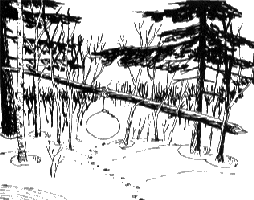
There is a bit of daylight showing over towards Cree Lake. There are long dawns and twilights in this country. Ab has slowed his pace to a brisk walk now and the dogs trot along easily. We come to a place in our toboggan trail at which we can see in the snow where a fox has just entered the trail and is following it ahead of us. My heart beats a bit faster when I remember that last time out we set a snare in our trail not far ahead of this point. It is a secret we had learned; foxes and also wolves will follow our trail for miles and we have snared some fine foxes in our own toboggan track. Alas, just before reaching the snare, this fox turns off to investigate some snowshoe rabbit trails. Ab moves the loop aside, we pass through and reset. We had been told in Big River that snares were useless north of the Churchill, but we had brought them along just in case the information was wrong. We had now reached the falls. We have an otter set in an open hole nearby and I look it over while Ab continues on above the falls to look at a mink set. The otter bait is intact but getting old and rotten looking, with brown thread like fungi trailing from it in the current. I replace it with a trout head before I rejoin Ab, who has nothing in the mink set. Right away, we spook a big herd of caribou; the dogs become insane with excitement and dash full tilt down the trail, heads up and tails curled upward and over the back, and me riding the tailboard and steering the toboggan so that it will not be smashed on a tree or rock. After a short, wild ride the caribou herd has vanished and we travel on at a normal pace. At the next fox set the bait has been stolen. We see the tracks coming from the north as he is drawn to the bait, his tracks circle the set, advance and withdraw a number of times, finally setting off the trap, taking the bait and moving off to the south. I lift the trap, shake off the snow, and reset in a quick movement of depressing the big springs with both hands while shoving sharply downward on the trap that rests across my knee. Ab says I have a strong grip. The trap is re-baited and camouflaged. We move on. We take nothing all the way to Albert's House on the first lake. As we come within sight of the cabin. I look at the otter set where the river just leaves the lake. I chop a small hole in the thin ice and peer down into the water. The trap is gone! I call to Ab who comes over, takes a look and enlarges the hole with his belt axe. We see the chain and the ring, still anchored to one of the poles that makes the pen. The chain leads downstream and out of sight under the ice. I pull out the pole and see the trap with the otter's foot neatly caught. I drag to the surface a full grown male, fat and heavy, rich brown in colour, drowned, stiff, ice cold and soaking wet. It has torn away part of the pen in its struggles. The pen is rebuilt, the trap rest and we ride on the ice to the cabin for the sun is going down and we are hungry and tired and ready for a rest. The sun sinks out of sight behind a big hill off to the south as we pull up to the cabin. The fire is soon crackling in the little tin stove in one corner, improvised from a discarded five-gallon oil tin. Grub box and bedrolls are taken inside. Spruce boughs are cut to make beds for the dogs who are chained to the small spruce trees a few yards from the door. Four large whitefish are brought in and stacked near the stove to partially thaw before feeding the dogs. We do not like to feed dogs on fish frozen so hard that they sound like two rocks when struck together. I skip down to the rapid nearby and dip a pail of water from an open hole. The water is clean, clear, sparkling and sweet tasting for it has run fast all the way from second lake, eight miles away over rock sand and bounding rapids, under ice all the way down. There is no human contamination or pollution here. I am thirsty from my long hike and take a drink. The water is so shockingly cold that my front teeth ache like they did when I was a kid eating an ice cream cone. I light a paraffin candle. We prepare the evening meal of caribou steak, gravy and bannock. The tea pail is filled and put on the stove to boil. We eat with appetites that, as always astonish us, consuming a great deal of meat. Then we sit back and rest, light our pipes and smoke; our conversation is to analyze the day's events. The dead otter is hung from the ridge pole and has dripped and dried off. Ab case skins it expertly. The brown pelt is carefully rolled up, tucked into a bag and placed in the coolest corner of the cabin. We wash up and clean the cabin and roll out our sleeping bags, ready to turn in. Ab's watch tells us that it is 9:30 P.M. I take the otter carcass outside and drape it over a pine branch.
We retire to immediate sleep that is dreamless and restful. Toward morning I am awakened by the low growling of the bitch and I know that timber wolves are prowling about, for she always sounds a warning when wolves are within scenting distance. There is frost rime on that part of my bedroll near my face as I prepare to rise. My bullet-shaped "Kaschie" lighter is used to ignite jackpine shavings cut the night before. I drop them into the stove, pile on more wood and very soon can feel the heat. We roll out of our beds and make breakfast. This meal is a repetition of last night's supper, but we eat heartily as usual. We are again on the trail before daylight, heading for camp two which lies ten miles generally westward, up the river. We take no furs at all on our journey to the lake. There are tracks of foxes about but they have missed going near our traps. When we arrive at the lake itself we pull over to a spruce-covered point on the north shore. We look at a fox set and discover a full-furred red fox caught well up on the front paw. It has been freshly caught and is full of fight. As we approach it slinks back against the snow, lays back and snarls. I lay it out with a solid head blow from the handle of my belt axe, then kneel on its chest until the heartbeat flutters and then stops. The night is spent at camp two. Located on a hillside it is in the green timber but overlooks a vast burned-over country where young jack pines have only grown a couple of feet tall. This view is somewhat depressing, for as far as we can see to the north there is nothing but bare hills with a few dry snags still standing here and there and downed timber everywhere. In the cold winter twilight we are aware of isolation and depression as intense cold builds up. However, if we look to the south we see fine green country once again. At daylight it is so cold that we decide to return to the home cabin and await a warmer trend in the weather. We are back at camp one for a noon meal, for the dogs have travelled well on the new trail and seem even more anxious to move on as we discover fresh wolf tracks on the trail. We have taken turns at riding the tailboard all the way down. The weather has moderated slightly. We decide to circle down the hook of lake one and return to the home cabin via Long Bay, for we have traps along the way that require attention; but it is the long way home. As we head far down the lake the dogs stop where the fresh tracks of three otters cut across our trail. They are travelling over the ice and we follow the tracks for a long way. Otters are sometimes encountered far out on the ice where they can be overtaken and killed. The trail veers west off to the west, where we know there is a small creek and good otter country. We have no time to investigate further but will check on the next trip around. When we turn off the ice and into the bush to get to Long Bay the trail runs through a thick stand of second-growth jack pines. Now a fox track appears on our trail. Our hopes are up for there is a snare set in the trail just ahead. We hurry the dogs along. As we round a bend in the trail the dogs lift their heads high for something black is on the trail. A half-silver fox had been neatly snared, then having jumped over a tree limb it had hanged itself. It is a beautiful specimen, heavily furred with black guard hair to its shoulders where the white guards begin and increase down the back and sides. We clap each other on the back and laugh for the pelt will bring sixty dollars. We pass through four or five miles of woods with no further incident. It is growing dusk as we emerge into Long Bay.
After we have eaten and done the evening camp chores, we sit on our bunks and rest. Ab flicks on the radio. Dr Brinkley is exhorting us again on the benefits of his health clinic in Mexico. We laugh for we do not need his services. We are healthy, hard and strong. There are other trapline trips that are made alone. Some of these are not productive and there are long, cold, and lonely journeys that produce nothing at all and make us feel useless and depressed. There are other trapline trips in which our fortune is so fantastic and such strange things happen that no one Outside would believe if we tell of them so we keep the information to ourselves. |
| Deep River Fur Farm |
| Deep River Trapping Page |
| Deep River Fishing Page |
| My Norwegian Roots |
| Early Mink People Canada - Bowness |
| The Manager's Tale - Hugh Ross |
| Sakitawak Bi-Centennial - 200 Yrs. |
| Lost Land of the Caribou - Ed Theriau |
| The History of Buffalo Narrows |
| Hugh (Lefty) McLeod, Bush Pilot |
| George Greening, Bush Pilot |
| Timber Trails - History of Big River |
| Joe Anstett, Trapper |
| Bill Windrum, Bush Pilot |
| Face the North Wind - Art Karas |
| North to Cree Lake - Art Karas |
| Look at the Past - History Dore Lake |
| George Abbott Family History |
| These Are The Prairies |
| William A. A. Jay, Trapper |
| John Hedlund, Trapper |
| Deep River Photo Gallery |
| Cyril Mahoney, Trapper |
| Saskatchewan Pictorial History |
| Who's Who in furs - 1956 |
| Century in the Making - Big River |
| Wings Beyond Road's End |
| The Northern Trapper, 1923 |
| My Various Links Page |
| Ron Clancy, Author |
| Roman Catholic Church - 1849 |
| Frontier Characters - Ron Clancy |
| Northern Trader - Ron Clancy |
| Various Deep River Videos |
| How the Indians Used the Birch |
| Mink and Fish - Buffalo Narrows |
| Gold and Other Stories - Richards |
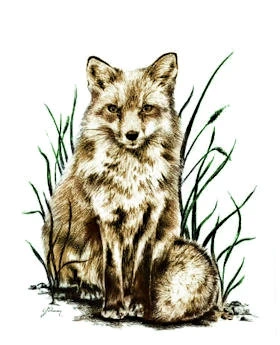 The big secret of fox trapping we discovered for ourselves. By the time we had spent the first winter at Cree Lake one basic principle had been learned. There are certain locations to set trap; and there are big areas where no traps need to be set, for the animal you are after rarely frequents such an area. The places that produce furs we call naturals, and it is a favoured spot frequented by animals of the same species year after year. There is of course, no object in setting a trap at a place where no fox will come in the course of a season. Strangely, we made our best fox catches in the same places, year after year, while a spot a few hundred yards away might never be visited at all by a fox in an entire winter.
The naturals for fox trapping were certain stretches of sandy beaches on Cree Lake shore, along certain trails, especially at the top of certain high-cut banks on the river's edge, in a defile between certain hills, and on some point of land that juts into a lake. As years passed it became quite clear to us where the naturals were and we picked them out easily when travelling into new country
The big secret of fox trapping we discovered for ourselves. By the time we had spent the first winter at Cree Lake one basic principle had been learned. There are certain locations to set trap; and there are big areas where no traps need to be set, for the animal you are after rarely frequents such an area. The places that produce furs we call naturals, and it is a favoured spot frequented by animals of the same species year after year. There is of course, no object in setting a trap at a place where no fox will come in the course of a season. Strangely, we made our best fox catches in the same places, year after year, while a spot a few hundred yards away might never be visited at all by a fox in an entire winter.
The naturals for fox trapping were certain stretches of sandy beaches on Cree Lake shore, along certain trails, especially at the top of certain high-cut banks on the river's edge, in a defile between certain hills, and on some point of land that juts into a lake. As years passed it became quite clear to us where the naturals were and we picked them out easily when travelling into new country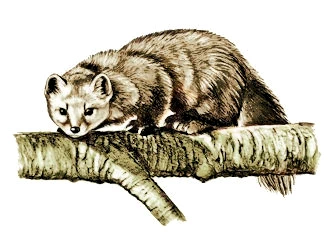 We found a stretch of hilly country that abounded in marten. These agile animals that successfully hunted red squirrels in the jack pine tops were found not far from our main cabin but nowhere else in the northland did we ever see their tracks. The principal of the natural holds for the big game hunter and the fisherman. Trapped animals, if alive, were dispatched as soon as we came upon them. We took no pleasure in the actual killing of these creatures. The thrill of catching the animal was somewhat marred by the utter cruelty of the steel trap and snare. There are unpleasant memories of the mounds of debris built up around the base of a tree where the trap was anchored, clawed in a heap by the animal reaching vainly with a free front foot to escape and dragging dirt, twigs, brush, leaves, and snow into a sickening monument to its pathetic struggles. There are recollections of broken and swollen legs of animals far too long in a trap.
We found a stretch of hilly country that abounded in marten. These agile animals that successfully hunted red squirrels in the jack pine tops were found not far from our main cabin but nowhere else in the northland did we ever see their tracks. The principal of the natural holds for the big game hunter and the fisherman. Trapped animals, if alive, were dispatched as soon as we came upon them. We took no pleasure in the actual killing of these creatures. The thrill of catching the animal was somewhat marred by the utter cruelty of the steel trap and snare. There are unpleasant memories of the mounds of debris built up around the base of a tree where the trap was anchored, clawed in a heap by the animal reaching vainly with a free front foot to escape and dragging dirt, twigs, brush, leaves, and snow into a sickening monument to its pathetic struggles. There are recollections of broken and swollen legs of animals far too long in a trap.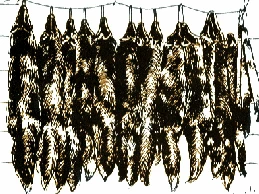 Snare marks can be seen or felt on the skin at the neck, and a vivid red tinge on the skin indicates strychnine. Trapping success was measured by the number of pelts taken and, in foxes, the percentage of "coloured" fur-darker colour phases in the same species which were much more valuable than the more common red foxes. Our foxes ranged in colour from light sorrel red, to deep rich red that gleams wickedly in certain lights, to cross foxes which varied from a touch of black underfur in a red pelt to the superior cross fox which had a small touch of red colouring in an almost black pelt and contrasting white guard hair, to the silver foxes that varied from almost black with a few white guard hairs to the full silver whose black pelt is liberally peppered with white guard hairs from the tip of his black nose to the white tip of his tail.
Snare marks can be seen or felt on the skin at the neck, and a vivid red tinge on the skin indicates strychnine. Trapping success was measured by the number of pelts taken and, in foxes, the percentage of "coloured" fur-darker colour phases in the same species which were much more valuable than the more common red foxes. Our foxes ranged in colour from light sorrel red, to deep rich red that gleams wickedly in certain lights, to cross foxes which varied from a touch of black underfur in a red pelt to the superior cross fox which had a small touch of red colouring in an almost black pelt and contrasting white guard hair, to the silver foxes that varied from almost black with a few white guard hairs to the full silver whose black pelt is liberally peppered with white guard hairs from the tip of his black nose to the white tip of his tail.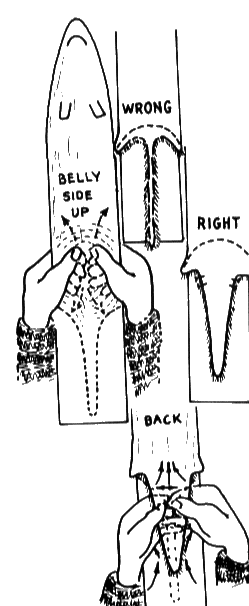
 The proper preparation of pelts was learned through observation, trial and error. Foxes are relatively simple to skin by splitting the hide on the inside of the hind legs down to the vent, and the tail skin is split to the very tip. The hide is then pulled off with as little cutting as possible so that the hide comes down over the shoulders, the front legs, and to the ears which are cut, and so on down to the nose which is cut off with the pelt. This is called case skinning. there is little cleaning on the skin side of an average fox pelt when place skin side out on a wooden stretcher When partially dried the hide is reversed to place the fur side out and again placed on the stretcher until dry. As soon as the drying process was complete the pelt was removed from the cabin and hung in cold storage in our small warehouse; here it was frequently checked for damage from mice which can create havoc if they get into a fur cache. Trappers made good use of needle and thread to hide flaws in long-haired fur pelts. When the pelt was freshly skinned, small rubbed spots may be removed by cutting out, the edges sewn together, and the pelt dried so that the mend is difficult to detect. I used the needle on many occasions to sew up cuts and rips in the hide. I have sold to some very shrewd fur buyers but I was never caught at it. I reasoned that there is a good deal of cutting and sewing together in a fur garment factory, and so I deceived with a clear conscience. A trapper told me that he had once stitched together the best parts of two damaged fox skins to make one good one. A fur buyer usually spends some time shaking and whipping each fox pelt to judge its value. This procedure consists of holding the pelt at the base of the tail, head end down, fingers gripping well into the pelt so the tail will not tear off. The head skin is gripped with the other hand and the pelt whipped until every hair stands straight out so that the texture, lustre, hair length, and colour can be exactly determined.
The proper preparation of pelts was learned through observation, trial and error. Foxes are relatively simple to skin by splitting the hide on the inside of the hind legs down to the vent, and the tail skin is split to the very tip. The hide is then pulled off with as little cutting as possible so that the hide comes down over the shoulders, the front legs, and to the ears which are cut, and so on down to the nose which is cut off with the pelt. This is called case skinning. there is little cleaning on the skin side of an average fox pelt when place skin side out on a wooden stretcher When partially dried the hide is reversed to place the fur side out and again placed on the stretcher until dry. As soon as the drying process was complete the pelt was removed from the cabin and hung in cold storage in our small warehouse; here it was frequently checked for damage from mice which can create havoc if they get into a fur cache. Trappers made good use of needle and thread to hide flaws in long-haired fur pelts. When the pelt was freshly skinned, small rubbed spots may be removed by cutting out, the edges sewn together, and the pelt dried so that the mend is difficult to detect. I used the needle on many occasions to sew up cuts and rips in the hide. I have sold to some very shrewd fur buyers but I was never caught at it. I reasoned that there is a good deal of cutting and sewing together in a fur garment factory, and so I deceived with a clear conscience. A trapper told me that he had once stitched together the best parts of two damaged fox skins to make one good one. A fur buyer usually spends some time shaking and whipping each fox pelt to judge its value. This procedure consists of holding the pelt at the base of the tail, head end down, fingers gripping well into the pelt so the tail will not tear off. The head skin is gripped with the other hand and the pelt whipped until every hair stands straight out so that the texture, lustre, hair length, and colour can be exactly determined.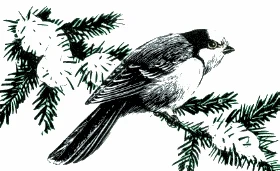 The whiskey jacks and ravens will feed on it. The night is still, very cold and the waxing moon is up over the hills. The sky is so clear and the moonlight so bright that I can count the jack pine needles against the sky on a branch just over my head. The white vapour and wood smoke rise straight up in a thin column from the tin stovepipe chimney. There are many caribou in a lush feeding ground to the south for I can see vapour from their bodies rising above the stunted spruce. The dogs are curled up tightly on their spruce bough beds. One lifts his head and howls and is joined by his mates, mournful notes that are the natural night chorus of these beasts. They become quiet. I look out on the white expanse of this as yet unnamed lake. It lies empty, silent, startlingly white in the moonlight with dark green backdrop. I reenter the cabin.
The whiskey jacks and ravens will feed on it. The night is still, very cold and the waxing moon is up over the hills. The sky is so clear and the moonlight so bright that I can count the jack pine needles against the sky on a branch just over my head. The white vapour and wood smoke rise straight up in a thin column from the tin stovepipe chimney. There are many caribou in a lush feeding ground to the south for I can see vapour from their bodies rising above the stunted spruce. The dogs are curled up tightly on their spruce bough beds. One lifts his head and howls and is joined by his mates, mournful notes that are the natural night chorus of these beasts. They become quiet. I look out on the white expanse of this as yet unnamed lake. It lies empty, silent, startlingly white in the moonlight with dark green backdrop. I reenter the cabin.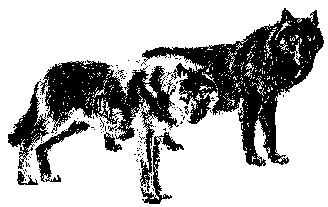 As we round a point we see seven timber wolves crossing the Bay and heading north. They stop and stand for a few seconds. This gives Ab enough time to unlimber the Winchester rifle and he fires rapidly three times. The wolves are streaking back from whence they came in full retreat. The ice is clear of wolves and we are disgusted and chagrined for they were in range. An inspection of the snow where they stood reveals an ivory-white broken fang and we know that we were very close to gathering a wolf pelt. I have never been so close to wolves and am a bit surprised to note that they were of different colours, tawny, grey, and one coal black. Now we reach the spot where the bush trail takes us overland to the home cabin. The moon is up to light the way as we pull into the little clearing in front of the cabin.
As we round a point we see seven timber wolves crossing the Bay and heading north. They stop and stand for a few seconds. This gives Ab enough time to unlimber the Winchester rifle and he fires rapidly three times. The wolves are streaking back from whence they came in full retreat. The ice is clear of wolves and we are disgusted and chagrined for they were in range. An inspection of the snow where they stood reveals an ivory-white broken fang and we know that we were very close to gathering a wolf pelt. I have never been so close to wolves and am a bit surprised to note that they were of different colours, tawny, grey, and one coal black. Now we reach the spot where the bush trail takes us overland to the home cabin. The moon is up to light the way as we pull into the little clearing in front of the cabin.